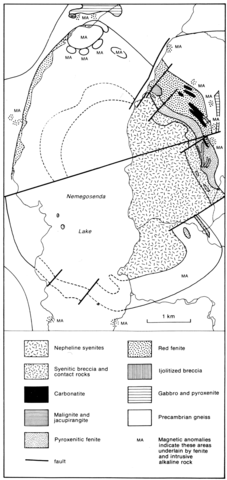stripes
This is an oval complex of 7x5 km, more than half of which is hidden beneath Nemegosenda Lake. It cuts Precambrian gneisses which are intruded by biotite pyroxenite and gabbro. The central part of the alkaline complex is occupied by nepheline syenites which pass outwards through mixed and brecciated rocks into a broad range of fenites which are cut by plugs, dykes and veins of alkaline silicate rocks and carbonatite. Only in the northeast is the geology reasonably well known through the agency of drilling. The core nepheline syenites are variably rich in nepheline with aegirine, biotite and sodic amphibole. Several fenite types have been distinguished; they usually contain sodic pyroxene and amphibole, but nepheline, wollastonite and melanite also occur, and both gneisses and gabbro have been fenitized. Within the fenites occur plugs, veins and breccia zones of malignite, biotite jacupirangite, biotite-feldspar pegmatite and biotite sovite, which are interpreted as being of intrusive, replacement and rheomorphic origin. Pseudoleucites occur in some malignites and are discussed and illustrated by Watkinson (1973). The complex is cut by feldspar porphyry, biotite-rich and carbonate-quartz-chlorite dykes and numerous carbonate veins. Oxygen isotope compositions of calcite from carbonatite were determined by Deines and Gold (1973, p. 1720).
BELL, K. and BLENKINSOP, J. 1980. Grant 42 ages and initial 87Sr-86Sr ratios from alkalic complexes of Ontario. Miscellaneous Paper, Ontario Geological Survey, 93: 16-23.
DEINES, P. and GOLD, D.P. 1973. The isotopic composition of carbonatite and kimberlite carbonates and their bearing on the isotopic composition of deep-seated carbon. Geochimica et Cosmochimica Acta, 37: 1709-33.
GITTINS, J., MACINTYRE, R.M. and YORK, D. 1967. The ages of carbonatite complexes in eastern Canada. Canadian Journal of Earth Sciences, 4: 651-5.
PARSONS, G.E. 1961. Niobium-bearing complexes east of Lake Superior. Geological Report, Ontario Department of Mines, 3: 1-73.
WATKINSON, D.H. 1973. Pseudoleucite from plutonic alkalic rock-carbonatite complexes. Canadian Mineralogist, 12: 129-34.

